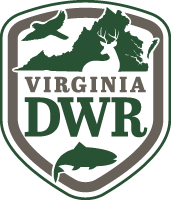
By Katie Martin, DWR Deer, Bear, Turkey Biologist
Photos by Meghan Marchetti/DWR
With nice weather, longer days, and plenty of outdoor recreation options across Virginia, it’s a great time of year to be out and about with your canine companions! Taking a few simple and precautionary measures will help you and your pet avoid negative encounters with black bears (or other wildlife) while enjoying your time outdoors.
When human-related foods are easily accessible, bears may venture closer to homes or recreation sites to access garbage, bird food, pet food, and grills so it is important to always remove or secure attractants that may lure a bear into your yard. Not sure what attracts a bear to your yard? See our website or BearWise® to learn more.
In most all situations bears, hearing dogs barking, may feel nervous and react most commonly by fleeing but they might also stand up to assess the threat, climb a tree, or remain still if the dog is far enough away. However, if a barking dog continues to approach the bear or chases the bear or offspring, the bear may be provoked into defending themselves through fighting or chasing off the dog, which can result in injuries to the dog and the bear. Also remember, if the bear decides to chase your unleashed dog, your dog will often run straight back to you!
At Home
Bears will travel through developed areas where you may not expect to see them, particularly in or near areas of natural cover like woods, creeks, or river corridors), and where food resources are available. An unleashed dog may attempt to chase or approach a bear that is in your yard, leading to an undesirable encounter.
To avoid an encounter between your dog and a bear in your yard or neighborhood it is important to:
- Feed your dog (and other pets) inside. If you must feed outdoors, make sure to clean up any spilled or uneaten food and store the empty bowl inside.
- Turn on a security or porch light, check your yard for signs of a bear, and make some noise before letting your dog out in the morning or evening when bears are most commonly active in the warmer months. Talking or clapping can avoid a surprise encounter by alerting a bear to your presence in order to give him or her time to leave the area.
- Always have your dog on a leash while walking in your neighborhood and be aware of your surroundings by looking for signs that a bear may be frequenting your yard.
- If you encounter a bear while out in the yard, do not run or let your dog chase after the bear! Recall your dog (if unleashed) and go inside.
- If your dog becomes engaged with a bear, DO NOT try to separate them or get in between your dog and the bear. Use loud noises, throw things, use pepper spray, a paintball gun, or water hose directed at the bear to chase him or her off.
While Recreating
During much of the year, both bears and people are often active in outdoor spaces. Bears frequent areas with abundant food resources like berry patches or places that provide a shady area to rest or cool off like in creek bottoms or around other water sources. Bears, like humans, enjoy taking the “easy road” and will commonly use the same trails and forest roads we do to navigate through areas thick with vegetation.
To avoid an encounter between your dog and a bear while recreating outdoors it is important to:
- Keep dogs leashed at all times and do not allow dogs to chase wildlife.
- Never leave your dog unattended or let him or her get out of your sight.
- Always be aware of your surroundings and avoid taking your dog into areas with concentrated bear sign (tracks, scat).
- When camping, feed your dog only as much as he or she will eat and pick up the rest. Store all food in wildlife resistant containers and clean up any spills.
- If you see a bear using the same trail as you and your dog, back up along the trail to give the bear time to run off. Never approach or run from the bear.
- Carry pepper spray in an accessible location, practice in advance, and know how to properly use it. Talk to your vet in advance about what to do if your dog is exposed to the spray while in a backcountry area.
- Familiarize yourself with how to appropriately recreate while in bear country
The best type of wildlife encounter for you and your pet is no encounter at all!
For more information regarding bears in Virginia including more tips on recreating in bear country visit:
https://dgifwebtest.gooutdoorsvirginia.com/wildlife/bear/ and https://bearwise.org/


